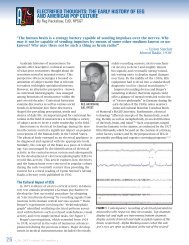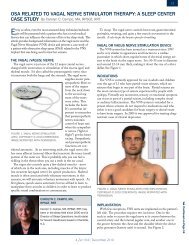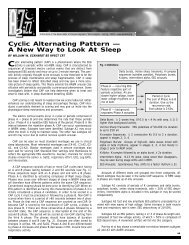Publication of the Association of Polysomnographic Technologists • 2006, Volume 15, Number 4 • www.aptweb.orgThey Come From the CortexBY WILL ECKHARDT, BS RPSGT CRT, ASSOCIATE EDITORWhere do scalp potentials come from and what produces thesevoltages? How do volume conduction, tissue dipoles and geometricorientation affect the electroencephalogram (EEG)? What in<strong>for</strong>mationcan we derive from these waves <strong>for</strong>ms once conducted throughtissue and recorded through our amplifiers? We will explore these issues.We record the EEG from scalp electrodes commonly placed by whatis know as the International 10-20 System of Electrode Placement(albeit modified generally in sleep studies). Hans Berger recorded thefirst human EEG in the1920’s. We have come along way in the equipmentused in recording the EEG but the source remains the same. EEGis a means of looking at voltages derived from our cortex which vary asa function of time and their spatial distribution in relation to the recordingelectrode.EEG can be recorded via scalp electrodes or from intracranial electrodes.Scalp sites sample from a larger area than intracranial placement.Intracranial sites provide more local sampling giving generallydifferent data from that of the global scalp recordings. Scalp EEG isnow believed to be derived from postsynaptic potentials (postsynapticpotentials are changes in the electrical potential of the neuron thatreceives in<strong>for</strong>mation at aneuronal junction orsynapse) from the cortexthat summate and reachthe scalp giving us ourEEG wave<strong>for</strong>ms. Intrinsiccell currents (produced byionic channel activation)may contribute to the EEGbut is still under investigation.Action potentialswere once thought tocontribute to the EEG butrecently have been dismissedas their temporallimits are too short.Fig. 1 Pyramidal CellFig. 2 Dipole28The cortex is composedof a dense collectionof neuron cell bodieswith myelinated andunmyelinated fibers runningthrough it. It is lessthen 5 mm thick. The cortexcovers both cerebralhemispheres of the brain.There are millions of neuronswithin the cortex,each having contact withthousands of other neurons.The cortex hasareas with distinct functionsand EEG output. Theneurons receive inputfrom subcortical areas viathe thalamus. The cerebral cortex andthe thalamus often work together in generatingbrain rhythms 1 . These wave<strong>for</strong>ms are derived from the summation ofdifferent rhythms rather than being arhythm generated by a single cell orgroup of cells. The cortex also sendsinput signals to other areas within thecortex via association fibers. EfferentWill Eckhardt(directed away) signals are sent to manyother brain structures e.g. the brainstem,thalamus, cerebellum, the basal nuclei and the spinal cord.Most of the cortex has six layers of neurons and is called the neocortex.Cytoarchitecture is the distribution of these neurons. Pyramidalcells (see Fig 2) the most common neurons within the cortex, arenamed such due to their cell body shape. Although they are found in alllayers other than layer 1, they are they are most predominant in layers2, 3, and 5. 2Pyramidal neurons have a cell body, an axon, a single apical dendriteand a number of basal dendrites. Their axon originating on the base ofthe cell body leaves the cortex being the output pathway of the cortex.Axons can branch many times contacting hundreds of other neurons.These neurons are layered and project into other areas via their axonsand axon collaterals. Pyramidal neurons are associated with excitatoryneurotransmitters. Other neurons in the cortex are local and stay withinthe area of their cell body. These are known as interneurons. Theseneurons are often inhibitory.Presently we believe EEG potentials are due to excitatory postsynapticpotentials (EPSP) and inhibitory postsynaptic potentials (IPSP) propagatedby the cell body and dendrites of thousands of synchronizedpyramidal neurons 3 . The summation of these potentials is facilitated buythe architecture of pyramidal neurons. These neurons are oriented in acolumnar structure with apical dendrites pointing toward the corticalsurface. These very small dipoles (see Fig 2 — a separation of unlikecharges) there<strong>for</strong>e have similar orientations. The Solid Angle (see Fig 3— a measure of the apparent cross-sectional area of an object asviewed from a distance) of the dipole and the actual voltage of the dipolegenerated by a single cell is too small to produce recordable EEG at thesurface. It is the summation of solid angles and synchronization of potentialsin groups of neuronal synapses that enables the EEG to be recordableat the surface of the head.There can be a great deal of difference in the recording from twoelectrodes spaced only millimeters apart which was previously thoughtto imply the activity was from the immediate proximity of the surfaceelectrode 4 . Those electrodes far apart and producing the same wave<strong>for</strong>ms were considered linked to a common source. The solid angle theorem(discussed below) and summation of the potentials is now consideredto be the means by which we record postsynaptic potentials at thesurface electrode.The small area within the cortex created by summated activity inneighboring active cells has been referred to as a dipole layer (see Fig.➟
Publication of the Association of Polysomnographic Technologists • 2006, Volume 15, Number 4 • www.aptweb.org2). A dipole layer can have infinite orientations with respect to scalpelectrodes. The electrodes on the scalp “see” only the potentials andpolarity of the potential pointed at them. Each orientation will producea unique result because of the effect on the solid angle (see Fig. 3) thedipole presents to the recording electrodes. The surface area of thedipole layer and the orientation of the layer with respect to the electrodeshave profound effects on the recording of electrical potentials.Due to volume conduction (the process of current flow through the tissuesbetween the electrical generator and the electrode) and summationof solid angles we see data from sources of at least several centimeters,independent of our electrode size, and potentially generatedby many local sources. Due to the solid angle theorem and volume conductionthe closest electrode to the neuronal generator may not alwaysrecord the largest potential 5 . Differing placement of the recording electrodearound the circumference of the area will result in markedchanges in the solid angle even though the event itself remainsunchanged. The polarity of the event also depends on electrode placementnot whether the event is due to EPSP or IPSP, the <strong>for</strong>mer beinga positive potential and the latter being negative.Sleep is a normal function of our brains. There are regions of thebrain and brainstem that promote wakefulness. As the influence of “thewakefulness generators decreases, neurons that promote sleepbecome active. Sleep ensues as a light transitional stage and becomesa more synchronized <strong>for</strong>m (within the bandwidth that we view inpolysomnography) as more neuronal networks are involved.Transmission between neurons is enhanced during wake and REMwhereas during NREM sleep a blocking of afferent in<strong>for</strong>mation is seen inthe thalamus 1 . The brains activity, during wake and REM, are nearly thesame. Although the afferent in<strong>for</strong>mation stops during NREM sleep, thecortex remains active. The corticothalamic conection remains active asdo the corticocortical communications. Brainstem stimulation and theresponse of the thalamocortical cells on the other hand are associatedwith EEG activation and neuronal excitability that creates an activatedstate vs. a sleep state.In conclusion what is it that the EEG shows me? As you know we candetermine NREM, REM, and wake. We can also determine normal EEG,being a lack of clinically significant patterns associated with disorders.Abnormal EEG can also be determined but does not necessarily mean aclinically significant disorder. This is why MRI is an often utilized diagnostictool in relation to brain function.Electrophysiologists study potentials generated by just one neuron oreven small groups recorded with microelectrodes or mesoelectrodes.We, in sleep, are dealing with oscillating macroscopic potentials recordedfrom the scalp 6 . To name a few illnesses that EEG may be utilized inthe diagnosis and treatment of: strokes, brain tumors, infectious diseases,severe head injury, and brain death. The EEG is merely one ofmany tools in assessment of brain function but remains the gold standardin evaluation of sleep state.Now I shall block the afferent in<strong>for</strong>mation from my brainstem reticular<strong>for</strong>mation and let sleep ensue. ★References:1. Mircea Steriade. Principles and <strong>Practice</strong> of Sleep Medicine 2006 Elsevier Chapter 9 BrainElectrical Activity and Sensory Processing During Waking and Sleep States:1012. Duane E. Haines. Fundamental Neuroscience, Second Edition:5083. Bruce J. Fisch. Fisch & Spehlmann’s EEG Primer Basic Principles of Digital and AnalogEEG, Third Revised and Enlarged Edition: 4-94. R Cooper, J.W. Osselton, J.C. Shaw. EEG Technology Second Edition: 8-135. Volume Conduction Principles in Clinical Neurosurgery. February 2005. VeterinaryNeurology and Neurosurgery.http://www.neurovet.org/Electrophysiology/VolumeConduction/VolCondPartABcite.htm6. Paul L. Nunez, Ramesh Srinivasan Electric Fields of the Brain The Neurophysics of EEGSecond Edition: 3-4About the AuthorWill Eckhardt, RPSGT, CRT, is a member of the <strong>APT</strong> Board of Directors and serves as the<strong>APT</strong> Board Liaison <strong>for</strong> the <strong>APT</strong> <strong>Standard</strong>s and Guidelines Committee. He is a board memberof the New England Polysomnographic Society (NEPS) and is NEPS Education CommitteeChair. His full time position is with Sleep HealthCenters where he is the Director of Education.Eckhardt also is a faculty member at Northern Essex Community College where he teachesin the polysomnography program and is a member of the advisory board. He is a member ofthe A2Zzz Magazine editorial board and a recipient of the <strong>APT</strong> Dr. Allen DeVilbiss LiteraryAward in 2004. He is also a member of the American Academy of Sleep Medicine Committeeon Polysomnographic Technologists Issues.Sleep Disorder TechnologistsUniversity ServicesSleep Diagnostic & Treatment CentersLocations in PA & NJLansdale, NE & South Phila, Pottstown, Warrington, West Chester, PA & Voorhees NJFig. 3 Solid Angle — The voltage recorded by each electrode is proportional tothe product of the solid angle and the actual voltage of the dipole. Even thoughthe cross-sectional area of the dipole layer is the same the voltages measuredby the two electrodes would differ from one another in amount because the solidangles are different.Full/ Part-time positions available. Qualified individuals shouldbe experienced in routine PSG testing, CPAP and BIPAPtitrations and nocturnal seizure testing. Opportunities <strong>for</strong> furthergrowth and development exist <strong>for</strong> motivated individuals. Sendresume to (610) 344-7922,employment@uservices.com.Or call (610) 344-9921 <strong>for</strong> further in<strong>for</strong>mation.Multiple locations, good working environment, competitive pay.www.uservices.com29














